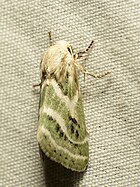Schinia trifascia
| Schinia trifascia | ||||||||||||
|---|---|---|---|---|---|---|---|---|---|---|---|---|

Schinia trifascia |
||||||||||||
| Systematics | ||||||||||||
|
||||||||||||
| Scientific name | ||||||||||||
| Schinia trifascia | ||||||||||||
| Huebner , 1818 |
Schinia trifascia is a butterfly found in North America( moth ) fromthe owl butterfly family (Noctuidae).
features
butterfly
The moths reach a wingspan of 20 to 31 millimeters. There is a slight difference in color between the sexes. The basic color of the upper fore wing varies in both sexes from pale green to olive green to brownish green. Typical of the species are three milky white transverse stripes on the upper side of the forewing, the inner of which delimits the basal region in an arcuate or acute angle. The middle and outer horizontal stripes are very straight. Ring and kidney defects are not recognizable. The hem area is slightly darkened. The upper side of the hind wing of the males is monochrome and whitish without drawing, whereas in the females it is darkened towards the edge. The thorax is hairy in tufts
Caterpillar
Adult caterpillars usually have a brownish, sometimes greenish color. The back line is dark brown or dark green. A more or less strongly developed dark marbling extends over the body surface. The head capsule is yellowish or greenish.
Similar species
- The moths of Schinia accessa differ by small black arrow brown spots which in the Diskal- and Postdiskalregion lift the front wing upper surface.
- The similarly drawn butterflies of Schinia grandimedia and Schinia oleagina differ in that they have more brown tones on the upper sides of the wings.
Distribution and occurrence
Schinia trifascia is found in southeastern Canada and the east and central United States . The distribution area extends from Ontario in the north to Texas in the west and to Florida in the south. The species prefers humid areas in which the host plant grows.
Way of life
The moths are nocturnal. They fly in one generation between July and October. Their main flight time includes the months of August and September. At night they visit artificial light sources . The caterpillars live on Eupatoria species , primarily Eupatorium sessilfolium or Brickellia eupatorioides . They prefer to feed on the flowers and seeds of their host plants.
Danger
The species is widespread in its range and mostly not rare. The US-based NatureServe organization has therefore classified it as " secure " (secured, not endangered).
Individual evidence
- ↑ a b Information from Iowa State University's BugGuide, [1]
- ↑ Distribution and flight time, [2]
- ↑ food plant, [3]
- ↑ Endangerment
literature
- Seabrooke Leckie & David Beadle: Peterson Field Guide to Moths of Southeastern North America , Houghton Mifflin Harcourt, Boston, New York, 2018, ISBN 978-0-544-25211-0
Web links
- mothphotographersgroup - Locations as reported by Mississippi State University
- it is.gov - taxonomy



